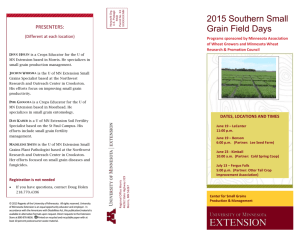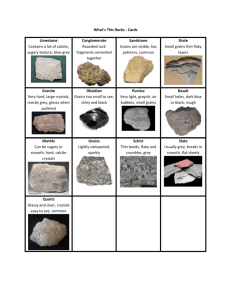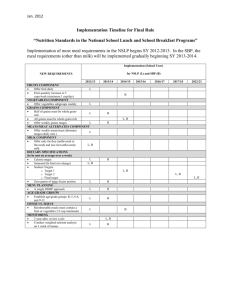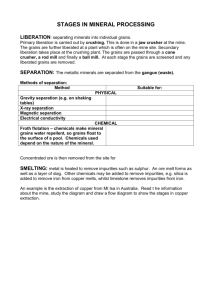Video transcript - Department of Agriculture
advertisement
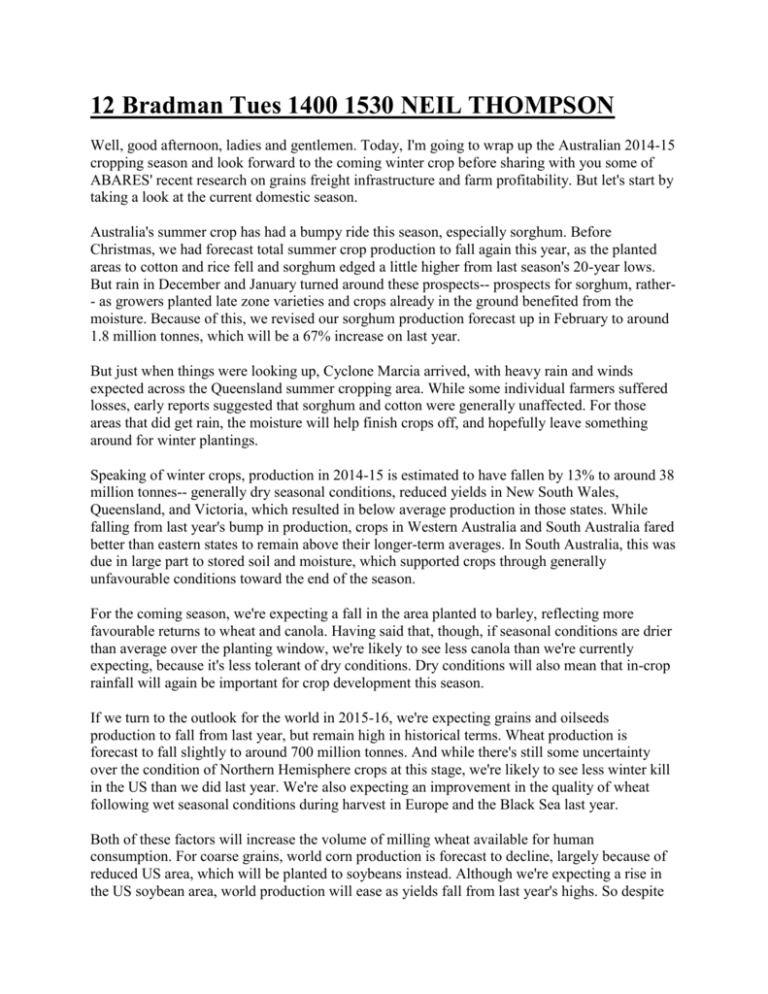
12 Bradman Tues 1400 1530 NEIL THOMPSON Well, good afternoon, ladies and gentlemen. Today, I'm going to wrap up the Australian 2014-15 cropping season and look forward to the coming winter crop before sharing with you some of ABARES' recent research on grains freight infrastructure and farm profitability. But let's start by taking a look at the current domestic season. Australia's summer crop has had a bumpy ride this season, especially sorghum. Before Christmas, we had forecast total summer crop production to fall again this year, as the planted areas to cotton and rice fell and sorghum edged a little higher from last season's 20-year lows. But rain in December and January turned around these prospects-- prospects for sorghum, rather- as growers planted late zone varieties and crops already in the ground benefited from the moisture. Because of this, we revised our sorghum production forecast up in February to around 1.8 million tonnes, which will be a 67% increase on last year. But just when things were looking up, Cyclone Marcia arrived, with heavy rain and winds expected across the Queensland summer cropping area. While some individual farmers suffered losses, early reports suggested that sorghum and cotton were generally unaffected. For those areas that did get rain, the moisture will help finish crops off, and hopefully leave something around for winter plantings. Speaking of winter crops, production in 2014-15 is estimated to have fallen by 13% to around 38 million tonnes-- generally dry seasonal conditions, reduced yields in New South Wales, Queensland, and Victoria, which resulted in below average production in those states. While falling from last year's bump in production, crops in Western Australia and South Australia fared better than eastern states to remain above their longer-term averages. In South Australia, this was due in large part to stored soil and moisture, which supported crops through generally unfavourable conditions toward the end of the season. For the coming season, we're expecting a fall in the area planted to barley, reflecting more favourable returns to wheat and canola. Having said that, though, if seasonal conditions are drier than average over the planting window, we're likely to see less canola than we're currently expecting, because it's less tolerant of dry conditions. Dry conditions will also mean that in-crop rainfall will again be important for crop development this season. If we turn to the outlook for the world in 2015-16, we're expecting grains and oilseeds production to fall from last year, but remain high in historical terms. Wheat production is forecast to fall slightly to around 700 million tonnes. And while there's still some uncertainty over the condition of Northern Hemisphere crops at this stage, we're likely to see less winter kill in the US than we did last year. We're also expecting an improvement in the quality of wheat following wet seasonal conditions during harvest in Europe and the Black Sea last year. Both of these factors will increase the volume of milling wheat available for human consumption. For coarse grains, world corn production is forecast to decline, largely because of reduced US area, which will be planted to soybeans instead. Although we're expecting a rise in the US soybean area, world production will ease as yields fall from last year's highs. So despite these forecast declines in production, world prices for wheat and soybeans are expected to fall. Wheat is forecast to edge lower, reflecting increased production of milling wheat, while soybeans are forecast to fall by 8%, reflecting world stocks reaching record highs. In contrast, the world corn price is forecast to rise slightly. Its consumption exceeds production for the first time in three years. Looking further into the future, growth in the consumption of grains and oil seeds will be concentrated in developing countries, driven by rising incomes and population growth. Asia will be at the centre of this demand, which is great news for Australian grains and oil seeds exporters. Feed demand will become increasingly important for coarse grains consumption over the medium term as growth in ethanol production slows. Japan and China are expected to remain large importers of corn for livestock feed, while for Australian producers, malt and barley demand in China and Southeast Asia will grow strongly as beer consumption rises in the region. Oilseed consumption will also benefit from greater livestock production, but it's expected to grow faster than coarse grains because of an increased demand for vegetables oils for human consumption. In Australia's largest wheat export market-- Indonesia-- consumption is forecast to rise by around 3% a year to reach over 8 million tonnes by 2020. With Asia set to remain the most important region for our grains and oilseeds industries over the foreseeable future, I'm glad we have David here from AGIC to share his thoughts on opportunities in Asia going forward. In terms of production over the medium term, we're expecting the largest gains to occur in lowcost producers, which will keep a lid on prices as consumption and demand increases. Expansion in low-cost producers, such as Brazil, Argentina, and the Black Sea region, are likely, because they have land available for expanded plantings, scope to improve infrastructure and technology, and particularly in the case of the Black Sea, the ability to enhance quality and yield. What this means for wheat is that despite world production and consumption growing at similar rates over the next five years, higher production in the Black Sea region will put downward pressure on world prices in real terms. Prices for corn and soybeans are likely to rise over the first couple of years of the projection period as a result of strong feed demand. But growers will respond towards the end of the period by producing more grains and oil seeds, which will see prices ease once again. So with the scene set for the world, let's take a look at the prospects for Australia over the next five years. Australian grains and oilseeds production is projected to edge higher on the back of yielding improvements over the medium term. Total planted area is expected to stay at around 22 main hectares, with the allocation of land to wheat, barley, and canola remaining largely unchanged. But 2019-20, total grains and oilseed production is projected to be just under 43 million tonnes. So without the prospect of significant increases in production and more competition in world markets from lower cost producers, productivity growth will be key to maintaining and improving farm [INAUDIBLE] returns for growers over the medium term. And to that end, ABARES is completing studies on farm profitability and freight infrastructure. If we take a look at profitability first, one of the interesting things we found is that farm size has a strong positive correlation with profitability. Now, I'm not just talking about physical size here, although that's important. Other factors include intensification and changes to farm systems to produce higher value outputs. Because profitability is not simply a function of physical size, we've used total farm receipts to distinguish between small and large farms. And as you can see from this graph, as farm receipts, our proxy for size increases. The rate of return on capital, or profitability, rises. So as well as being the most profitable, large farms account for the bulk of Australian grains and oilseeds production. Farms with more than $1 million in receipts produce around 70% of total grains and and oilseeds production, but account for any around 30% of the total number of farms. At the other end of the scale, operations of less than $200,000 account for 25% of the farm population, but produce only around 3% of grains. So the reason why larger farms are generally more profitable has a lot to do with their productivity. A number of ABARES and [? GREC ?] studies have found that the general drivers of productivity growth in the grains sector include improved plant varieties and better knowledge about cropping systems, increased use of new technology, and, of course, increased scale. But while productivity has increased on average by around 1.5% a year for cropping specialists, the best performing farms improved faster than the average rate, because they adopt new ideas and technology sooner and make better use of them. If we look at new technology specifically, the most profitable farms are more likely to adopt earlier, because their size allows them to benefit more from unit cost reductions, while technology companies direct research to them because they're more likely to be able to finance new equipment. Farm management also plays an important role in that managers of the most profitable farms take on new technology sooner because they're less risk averse, have skills and experience with existing technology, or have a larger workforce, which can have a wider skill set. So while I've focused on large farms here, the takeaway for small operators looking to improve profits is that more land is not the only option. Using new technology and farm practises sooner and better also plays a role-- an important role-- in longer-term profitability. If you came to hear more on profitability and farm performance more generally, then the session following afternoon tea in the royal theatre will be a muse see for you. So turning to our work on infrastructure, transport accounts for a significant proportion of total producer costs. In a soon-to-be-released study of wheat supply chains, ABARES is undertaking some modelling on the future needs of grain freight infrastructure in WA. To do this, we've taken a scenario from the WA Department of Agriculture that projects annual wheat production to rise to 10.3 million tonnes by 2035. This is up from the 20-year average in 2011 of 6.3 million tonnes. On the basis of this production rise, it won't surprise you that we're expecting significant increases in road and rail use for wheat transport. Although our preliminary results show the greatest increase in transport would be by road, rail would still account for around 80% of total wheat freight in WA. While we're finalising our work on future need and how it can be met, our initial results have highlighted a couple of challenges. The first is funding the required infrastructure maintenance and upgrades to meet future demand, while the second relates to meeting the demand of multiple users that rely on a mix of different transport types. Like I said, our work is ongoing. But in the meantime, I'm glad that Luke is here to tell us all about the future of grains transport in Australia. Before I finish, I'd just like to thank John and the [? GREC ?] for their continuing support of outlook, and also any of our survey cooperators here in the room, because they make an important contribution to our research. Thank you very much. [APPLAUSE]



